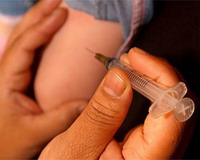American children get useless vaccines
American children go through the tearful ordeal of getting their vaccinations, only to be forced to do it all over again, because the vaccines were duds, ruined by poor refrigeration.

It is more than a source of distress for parent and child. It is a public health threat, because youngsters given understrength vaccines are unprotected against dangerous diseases. And it accounts for a big part of the $20 million (13.5 million EUR) in waste incurred by the U.S. Vaccines for Children program.
"This is a substantial problem that needs to be addressed through prevention, and when problems are discovered, often times through revaccinations," said Dr. Lance Rodewald, director of immunization services at the U.S. Centers for Disease Control and Prevention in Atlanta.
By CDC estimates, hundreds of thousands of doses of vaccines against such diseases as flu, diphtheria, tetanus, whooping cough, polio, mumps, measles, chicken pox and the cervical cancer virus are thrown out each year because of poor refrigeration at clinics, hospitals and doctors' offices.
In one recent case in Iowa, more than 1,000 families were notified by letter and telephone that they needed to get their children revaccinated. State officials found that the refrigerator at the clinic that administered the shots repeatedly dropped below freezing over a 17-month period in 2005 and 2006, potentially ruining the vaccines stored there.
"We just didn't notice it," said Dr. Ray Sturdevant, president of the Prairie Pediatrics and Adolescent Clinic.
Poor refrigeration has been blamed for similar problems elsewhere around the United States over the past 2 1/2 years:
- In Minnesota, a clinic had to revaccinate 8,600 patients, most of them children.
- In Oregon, 500 children and adults had to get another shot.
- In Florida, it happened to about 250 kids.
In Sioux City and other cases, the spoilage resulted from a combination of factors: The refrigerator malfunctioned or was not set or maintained at the proper temperature - a problem that can be caused simply by leaving the door open for a while - and the workers responsible for regularly logging the temperature did not seem to recognize when the readings were off.
"We do everything we can to advise and to make people aware that this is very expensive vaccines they're dealing with and we really want to handle it properly and store it properly to prevent these things from happening - but they do," said Charles Alexander, chief of immunization with the Florida Health Department.
Inadequate refrigeration can cause vaccines to lose their potency, although experts say spoiled childhood vaccines are not dangerous in themselves if given to a youngster.
And there are no known cases of children contracting a disease because they had been given a vaccine rendered ineffective by poor refrigeration. But it could happen, and "that's why we're concerned about it," Rodewald said.
Since 2000, the CDC has pushed state health departments to visit clinics and check their refrigerators. Most states require clinics to use refrigerators with reliable thermometers that can be monitored, and staff members must know what to do when temperatures are above or below the proper range, Rodewald said.
Waste costs the $2 billion (1.4 billion EUR)-a-year federal Vaccines for Children Program about $20 million a year, and the biggest single problem is improper refrigeration, Rodewald said. Other causes: The vaccines expire or were damaged in shipment.
Rodewald had no breakdown of how much in waste is attributable to poor refrigeration. But he emphasized that the losses amount to an extremely small percentage of the childhood vaccine program.
"The childhood program saves $10 billion (6.7 billion EUR) each year in direct health care costs by preventing disease among children," he said. "Although preventing vaccine wastage is a priority, the amount wasted should be placed in the context of the overall program economic benefits."
Altogether in 2006, there were 32 instances in Iowa in which vaccines were not refrigerated correctly, said Dr. Patricia Quinlisk, state epidemiologist. Quinlisk would not say how many patients were affected, but estimated $750,000 (508,785 EUR) worth of vaccine in the Vaccine for Children Program was wasted.
"We will get months and months and months of vaccine refrigerator logs where the refrigerator is out of the temperature and nobody has done anything except every day mark down it's out of temperature," she said.
In the Minnesota case, the refrigerator was not kept at the proper temperature and there were gaps in documentation, said Jill Marette of the Minnesota Department of Health.
"It's stressful to vaccinate your children in the first place - just the idea of giving them all those shots. Then you have to think about getting revaccinated," Marette said.
Of greatest concern is the chickenpox vaccine. It must be kept frozen at an average temperature of 5 degrees (-15 Celsius) or lower and should be kept in the dark. Children who receive an ineffective vaccine could easily become infected because the disease is fairly common in the U.S.
Dr. Joseph Bocchini, chairman of the Committee on Infectious Diseases with the American Academy of Pediatrics, said his group and others have issued clear recommendations about storing vaccines, and refrigerators can be equipped with alarms that sound when the temperature goes out of range.
Subscribe to Pravda.Ru Telegram channel, Facebook, RSS!





